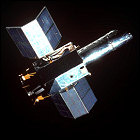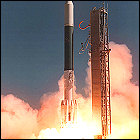International Ultraviolet Explorer shuts down
 Launched in 1978 as a joint venture between NASA and ESA, the unmanned International Ultraviolet Explorer is commanded to exhaust its remaining fuel and cease all contact with Earth. Though its detectors and other instruments are still functioning well after 18 years in orbit, its stabilization gyros have failed one by one until the satellite is unable to be aimed at deep space targets with any accuracy. IUE remains powered down, adrift in a geosynchronous orbit.
Launched in 1978 as a joint venture between NASA and ESA, the unmanned International Ultraviolet Explorer is commanded to exhaust its remaining fuel and cease all contact with Earth. Though its detectors and other instruments are still functioning well after 18 years in orbit, its stabilization gyros have failed one by one until the satellite is unable to be aimed at deep space targets with any accuracy. IUE remains powered down, adrift in a geosynchronous orbit.
International Ultraviolet Explorer
 A joint project between NASA and the European Space Agency, the International Ultraviolet Explorer is launched atop a Delta rocket from Cape Canaveral. The precursor of later space-based telescopes such as the Hubble Space Telescope, IUE produces no photographic images, instead concentrating on detecting ultraviolet emissions from distant objects. IUE adds significantly to the growing body of space science, and is the first satellite to give astronomers the chance to immediately aim its detectors at targets that yield unexpected results, allowing it to respond swiftly to such rapidly developing phenomena as Supernova 1987A. Designed to stay operational for three years, IUE will remain online for almost two decades.
A joint project between NASA and the European Space Agency, the International Ultraviolet Explorer is launched atop a Delta rocket from Cape Canaveral. The precursor of later space-based telescopes such as the Hubble Space Telescope, IUE produces no photographic images, instead concentrating on detecting ultraviolet emissions from distant objects. IUE adds significantly to the growing body of space science, and is the first satellite to give astronomers the chance to immediately aim its detectors at targets that yield unexpected results, allowing it to respond swiftly to such rapidly developing phenomena as Supernova 1987A. Designed to stay operational for three years, IUE will remain online for almost two decades.